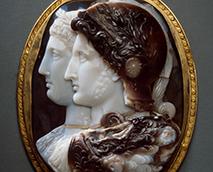Annotations
Named after its Renaissance owners, the Gonzaga family, dukes of Mantua, this cameo is perhaps one of the most famous monuments of Classical Antiquity. In glyptics (miniature carving on coloured stones), cameos ((gems carved in relief on multi-layered colour stones) first appeared during the Hellenist period (late 4th - 1st centuries BC). The centre of production was Alexandria in Egypt and it was an Alexandrian master of the 3rd century BC who carved this work on a large piece of Arabian sardonyx, playing on all the stone's inherently painterly qualities. In this paired portrait of Ptolemy II Philadelphus with his wife and sister Arsinoё II, deified rulers of Egypt, the engraver, like the poet Theocritus, likened the subjects to the "rulers of Mount Olympus", the brother and sister Zeus and Hera who concluded a "holy marriage". The manly and passionate face of the ruler contrasts with Arsinoё's calm, classically correct profile. The two faces are carved in the middle, lighter layer of agate, from beneath which we can see the third, greyish layer shining through and forming a background, which creates an effect as if Arsinoe's face were in the shade. The hair, helmet and shield (aegis) of Ptolemy/Zeus are set in the upper, brown layer of stone, its light incrustations used to pick out the rosette on the helmet and also the heads of Medusa and Phobos (personification of Fear) on the shield. Large cameos of agate - a material harder than steel - took several years to produce and were thus extremely expensive. The Gonzaga Cameo is a marvellous example of the luxury of Ptolemy's court. It must have served as an object of adoration and a symbol of the cult of these new ruler-gods. (from Hermitage Museum site)

